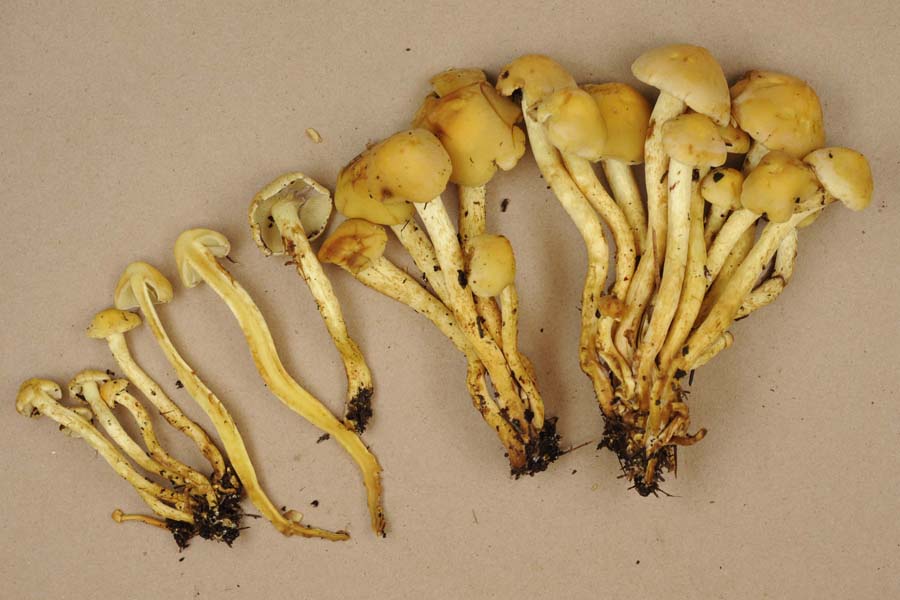Hypholoma fasciculare — Sulphur tuft
Odour: Indistinct.
Taste: Intensely bitter (taste no more than a pea-sized portion, then spit it out).
Cap: 1–6 (–10) cm in diameter. The cap starts out with an inrolled margin and sometimes, a central umbo. As the cap expands, it flattens, often keeping the low umbo. The colour varies, starting out light yellow, yellow-orange or yellow-brown. It is darkest at centre. After heavy rain or with age, caps darken and may be smudged with the purple-black spores. The surface is smooth, not sticky. Fibrils from the veil, sometimes coloured purple-black due to adhering spores, may remain attached to the cap margin.
Gills: Crowded, narrowly attached to the stem. The colour starts out pale yellow, often with a greenish cast and darkens as the spores mature, ending up dark grey-brown with violaceous or purplish tinges and a hint of green.
Stem: 3–7 cm long x 0.2 –0.7 cm wide, cylindrical, becoming hollow. Yellow to yellow brown, especially at the base.
Ring or veil: A fibrillose veil stretches between the cap margin and the stem and its remains may be visible on the stem due to the dark purple spores that adhere to it.
Cup: None.
Spores: 6.5–8 x 3.5–4.5 µm, smooth with a small germ pore.
Habitat: Clustered and forming big clumps or troops on both hardwood and conifer wood, logs, stumps, and woodchips in all kinds of forests, and in the human environment. It can cover whole logs. Saprotrophic.
Geographic distribution: Common and widespread throughout the temperate parts of the Northern Hemisphere.
Honey mushrooms (Armillaria species) grow in big clusters on and around wood. These have white spores, the pink-brown cap is scaly, and when young, they have a distinct felty or cottony ring on the stem. While some people eat honey mushrooms, they have caused gastrointestinal upsets in more than a few individuals.
Toxins6: Sulphur tufts contain triterpenoids (fasciculol E and F). Although toxic when injected into mice, it is not clear whether these compounds cause the gastrointestinal problems seen in people.
Symptoms: Time of onset is 5–10 hours after consumption. Severe gastrointestinal distress has resulted with nausea, vomiting, explosive diarrhoea, excess protein in urine, and distorted sensory experiences7,8.
Treatment: Contact your regional Poison Control Centre if you or someone you know is ill after eating sulphur tufts. Poison centres provide free, expert medical advice 24 hours a day, seven days a week. If possible, save the mushrooms or some of the leftover food containing the mushrooms to help confirm identification.
Poison Control:
British Columbia: 604-682-5050 or 1-800-567-8911.
United States (WA, OR, ID): 1-800-222-1222.


